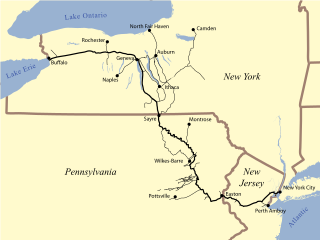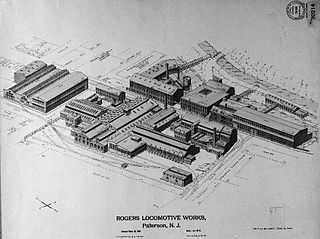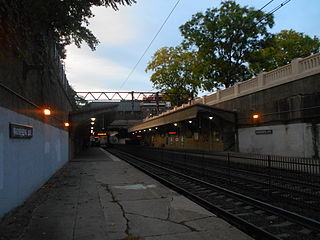
The Bethlehem Steel Corporation was an American company that for much of the 20th century was one of the world's largest steel producing and shipbuilding companies.

Joseph Wharton was an American industrialist. He was involved in mining, manufacturing and education. He founded the Wharton School at the University of Pennsylvania, co-founded the Bethlehem Steel company, and was one of the founders of Swarthmore College.

Union Iron Works, located in San Francisco, California, on the southeast waterfront, was a central business within the large industrial zone of Potrero Point, for four decades at the end of the nineteenth and beginning of the twentieth centuries.

The Lehigh Valley Railroad was one of a number of railroads built in the northeastern United States primarily to haul anthracite coal from the Pennsylvania Coal Region. The railroad was authorized on April 21, 1846, for freight and transportation of passengers, goods, wares, merchandise and minerals in the U.S. state of Pennsylvania and the railroad was incorporated/established on September 20, 1847, as the Delaware, Lehigh, Schuylkill and Susquehanna Railroad Company. On January 7, 1853, the railroad's name was changed to Lehigh Valley Railroad. It was sometimes known as the Route of the Black Diamond, named after the anthracite it transported. At the time, anthracite was transported by boat down the Lehigh River; the railroad was meant to be faster transportation. The railroad ended operations in 1976 and merged into Conrail along with several northeastern railroads that same year.

Rogers Locomotive and Machine Works was a 19th-century manufacturer of railroad steam locomotives based in Paterson, in Passaic County, New Jersey, in the United States. It built more than six thousand steam locomotives for railroads around the world. Most 19th-century U.S. railroads owned at least one Rogers-built locomotive. The company's most famous product was a locomotive named The General, built in December 1855, which was one of the principals of the Great Locomotive Chase of the American Civil War.

Bethlehem Steel Corporation Shipbuilding Division was created in 1905 when the Bethlehem Steel Corporation of Bethlehem, Pennsylvania, acquired the San Francisco shipyard Union Iron Works. In 1917 it was incorporated as Bethlehem Shipbuilding Corporation, Limited.
Gilbert Dayton Hedden, Sr. was an American industrialist, politician and treasure hunter. He was Mayor of Chatham Borough, New Jersey from 1934 to 1938 and is most notable today for the progress he made in the 1930s towards solving the Oak Island treasure mystery, described as the costliest treasure hunt ever.

The Hedden Construction Company was a prolific builder based in Newark, New Jersey in the early 20th century. Some of the finest buildings in New Jersey, New York City, and other large eastern cities were built by the company. Among the most notable is the Metropolitan Life Insurance Company Tower in New York City, the world's tallest building from 1909 to 1913 and home to the Hedden Construction Company's main offices located on the 36th and 37th floors. During this prosperous period over $40,000,000 in construction contracts and payments were collected by the firm.

The Lehigh Crane Iron Company was a major ironmaking firm in the Lehigh Valley from its founding in 1839 until its sale in 1899. It was founded under the patronage of Josiah White and Erskine Hazard, and financed by their Lehigh Coal & Navigation Company, which hoped to promote the then-novel technique of smelting iron ore with anthracite coal. This was an important cost and energy savings technique, since either an expensive charcoaling nor coke producing process and transport costs was totally eliminated so produced a great acceleration in the underpinnings of the American industrial revolution.

Watsessing Avenue is a New Jersey Transit rail station in Bloomfield, New Jersey, along the Montclair-Boonton Line. It is located beneath the Bloomfield Police Benevolent Association meeting hall near the corner of Watsessing Avenue and Orange Street in Bloomfield. It is one of two stations on the line where the boarding platform is below ground level. The Watsessing station and the Kingsland station in Lyndhurst on the Main Line shared similar designs and were built about the same time.

The Thomas Iron Company was a major iron-making firm in the Lehigh Valley from its organization in 1854 until its decline and eventual dismantling in the early 20th century. The firm was named in honor of its founder, David Thomas, who had emigrated to the United States in 1839 to introduce hot blast iron making in the Lehigh Valley, and now embarked on an independent ironmaking venture. The company's main and original plant was in Hokendauqua, Pennsylvania, which grew up around it; it also came to own blast furnaces and railroads elsewhere in the Lehigh Valley and mines in both Pennsylvania and New Jersey. Changes in the iron industry in the early Twentieth Century left Thomas Iron struggling to compete, and after a failed attempt at modernization and revival from 1913 to 1916, the company's assets were sold and largely dismantled during the 1920s.

The Cambria Iron Company of Johnstown, Pennsylvania was a major 19th-century industrial producer of iron and steel. Founded in 1852, it had the nation's largest steel foundry in the 1870s, and was renamed the Cambria Steel Company in 1898. The company used many innovations in the steelmaking process, including those of William Kelly and Henry Bessemer. The company was acquired in 1923 by the Bethlehem Steel Company. The company's historic facilities, extending some 12 miles (19 km) along the Conemaugh and Little Conemaugh Rivers, are a National Historic Landmark District.

Harlan & Hollingsworth was a Wilmington, Delaware, firm that constructed ships and railroad cars during the 19th century and into the 20th century.

Nittany Furnace, known earlier as Valentine Furnace, was a hot blast iron furnace located in Spring Township, Centre County, Pennsylvania, United States. Placed in operation in 1888 on the site of an older furnace, it was an important feature of Bellefonte economic life until it closed in 1911, no longer able to compete with more modern steel producers.
The Allegheny and South Side Railway is an historic railroad that operated in Pennsylvania.

The Tennessee Coal, Iron and Railroad Company (1852–1952), also known as TCI and the Tennessee Company, was a major American steel manufacturer with interests in coal and iron ore mining and railroad operations. Originally based entirely within Tennessee, it relocated most of its business to Alabama in the late nineteenth century. With a sizable real estate portfolio, the company owned several Birmingham satellite towns, including Ensley, Fairfield, Docena, Edgewater and Bayview. It also established a coal mining camp it sold to U.S. Steel which developed it into the Westfield, Alabama planned community.
The Lackawanna Steel Company was an American steel manufacturing company that existed as an independent company from 1840 to 1922, and as a subsidiary of the Bethlehem Steel company from 1922 to 1983. Founded by the Scranton family, it was once the second-largest steel company in the world. Scranton, Pennsylvania developed around the company's original location. When the company moved to a suburb of Buffalo, New York, in 1902, it stimulated the founding of the city of Lackawanna.
The United States Shipbuilding Company was a short-lived trust made up of seven shipbuilding companies, a property owner and steel company. Its stocks and bonds were unattractive to investors, and several of its member shipyards were overvalued, conditions which brought down the company less than a year after it was formed in 1902. The company was replaced by the Bethlehem Steel Corporation in 1904.

Robert Heysham Sayre was vice president and chief engineer of the Lehigh Valley Railroad. He was also vice president and general manager of Bethlehem Iron Company, precursor of Bethlehem Steel Corporation. The borough of Sayre, Pennsylvania and the small city of Sayre, Oklahoma were named in his honor.

The Hunter's Run and Slate Belt Railroad was a railway line from the Hunter's Run junction of the Gettysburg and Harrisburg Railway that ran southwestward along the south side of Mountain Creek to the Pine Grove Iron Works. The line serviced facilities for mining, for manufacturing, and for recreation. Portions of the railbed are a section of the Appalachian Trail as well as the majority of the Cumberland County Biker/Hiker Trail and the entire "Old Railroad Bed Road" that is the southeast border of Pine Grove Furnace State Park.















